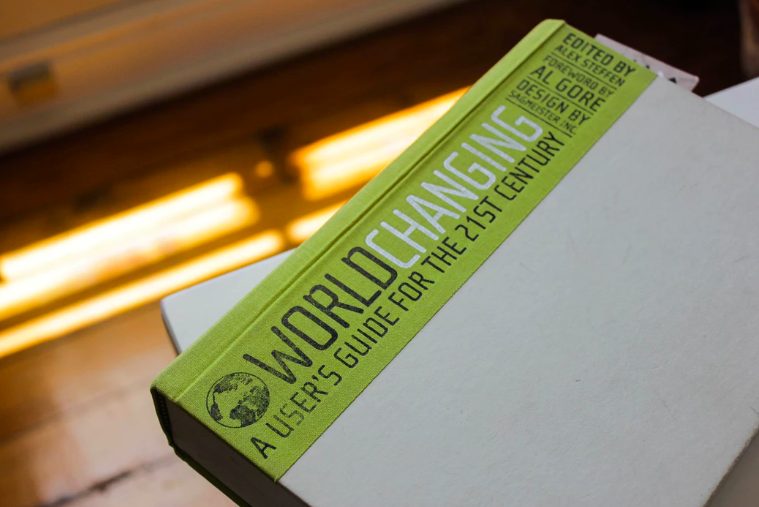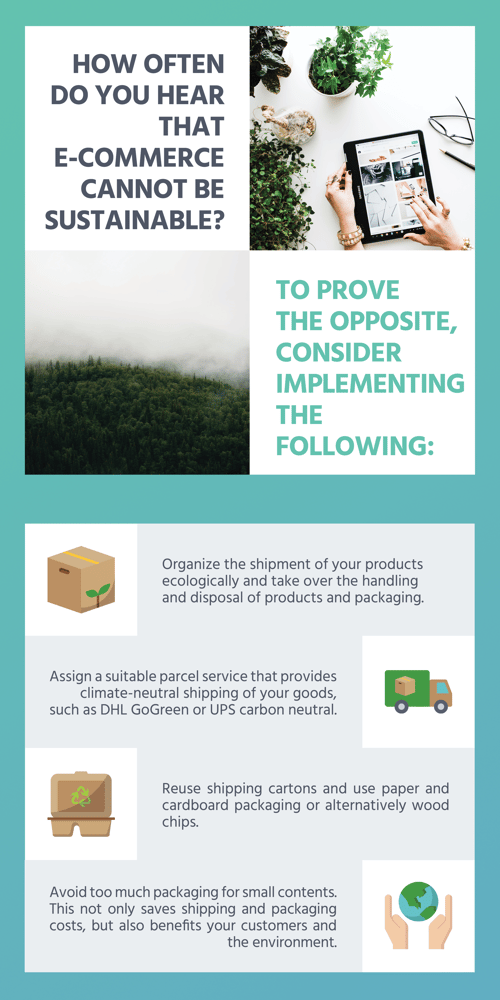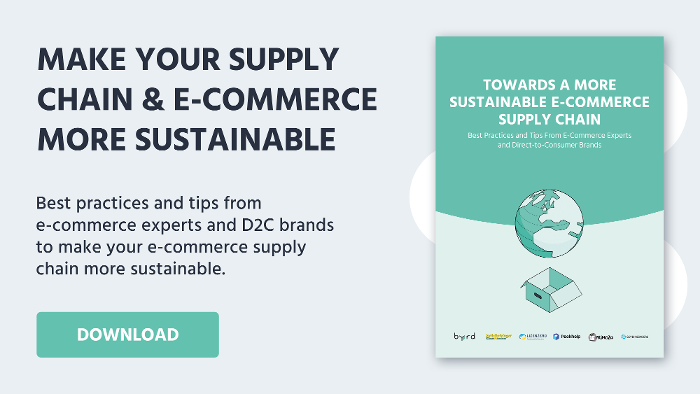The rise of sustainable e-commerce
Table of Content
Sustainability is not a negligible factor for online shops. The growing trend of environmental sustainability is humanity’s reflex to fight the destructive nature of the “grow or die” imperative of capitalism. In e-commerce, the concept of sustainability can range from business models to packaging products and its role will become increasingly important in the coming years.
Environmental and sustainability awareness has long been a trend in e-commerce. In a bid to successfully address increasing demands for sustainability from their consumers, online retailers have been pondering for some time now on topics like corporate social responsibility and eco-friendly approaches in the supply chain.
The impact of growing e-commerce on the environment
The Sustainability Annual Trends report, produced by the think tank agency SustainAbility, indicates that e-commerce has experienced rapid growth in recent years and by doing so, this had an unprecedented environmental impact.
To put this into perspective, more than 2 billion tons of waste end up in landfills worldwide annually. All those cardboard boxes, plastic packing puffs, and Styrofoam peanuts have to be disposed of somewhere… and more often than not, that “somewhere” is the Great Pacific Garbage Patch.
However, there is some hope left. For example, the sheer volume of waste produced by the supply-chain network and its dire impact on the environment has already rendered it necessary for e-commerce companies to rethink their practices and find sustainable solutions within the industry – most notably by adopting eco-friendly packaging.
The trend from recent years shows that many retailers have already given an ecological makeover to their products and have entered the green business with furniture and home accessories made of wooden pallets, paper, cardboard, or cork. In terms of environmental friendliness, some online shops have already established themselves with a sustainable business concept.
To help retailers to switch to using sustainable packaging for their products, Packhelp has launched an initiative that enables companies to source sustainable and ecological packaging materials. Online shops that order from Packhelp can also choose to plant trees. Support for reforestation can be seen, among other things, in the eco-badge that is applied to the boxes.
TOMS, for example, has become an internationally recognized brand whose packaging is mainly made out of recycled waste material (80%) and printed with soy ink. Parts of TOMS Shoes collection are made of natural hemp, organic cotton, and/or recycled polyester.
Also, shops like memolife, Mehr Grün, and 4betterdays actively promote sustainability and mainly sell ecological and fair trade products.

Sustainability in online shopping: What consumers pay attention to while shopping online
Environmentally friendly shipping options
A commendable development is emerging in sustainable shipping options. If they had the choice, 86% of Germans would rather choose environmentally friendly shipping. However, for two-thirds of the respondents, shipping price is an important factor. Cost-cautions consumers see additional costs for environmentally friendly shipping as unfavorable and would rather opt for the standard “free shipping” option. On the other hand, more than one in five Germans is willing to pay more if it helps to protect the environment. According to the respondents, the surcharge, though, should not be more than 5%. Climate-neutral shipping solutions are offered by DHL GoGreen, DPD Total Zero, or GLS ThinkGreen, for example, with whom we are also working together.
Even though it is important to offer express delivery for some product categories, as an online retailer you should know that it is not ecological. By doing so, you show your customers that you are paying attention to this topic and thus additionally strengthen your brand.
Green e-commerce - Avoiding packaging waste
Besides using sustainable and recyclable materials for the packaging and opting for climate-neutral shipping options, e-commerce businesses can also optimize their waste management – by completely eliminating packaging waste. In light of this endeavor, it is important to note that almost all online shoppers from Germany already pay close attention to packaging and are waste-cautious. Therefore, using renewable materials and reducing packaging waste to a minimum, is the new standard and brands need to address this if they wish to appeal to their consumers.
Many of us grew up with the terms "reduce, reuse, recycle" in our vocabulary. Nowadays, it's important for your business to reflect those same values. Not only to help the environment but also to increase brand loyalty among environmentally conscious customers. This can be achieved, for example, by using recycled material.
The implementation of sustainable packaging requires some research. You have to find out which packaging design can best represent your brand. An example would be Sheyn, a Vienna-based jewelry studio specializing in simple but elegant design. For shipping, Sheyn uses an eco-dispatch box that is made of 80% recycled material. This transfers the unique design to the packaging and in return, the customer has an unforgettable unboxing experience based on environmentally friendly packaging. A sustainable packaging design that emphasizes reusability can positively influence the brand loyalty of your customers.
Another example for stationary retailers would be to design their packaging with a different purpose in mind.
For example, H&M has a shopping bag that turns into a clothes hanger. These bags not only consist of less material than the traditional plastic bag from H&M, but 80% of the paper used is also recycled. H&M is aware that its customers are people between the ages of 18 and 35 who care about the environment and appreciate reusable packaging solutions. Therefore, sustainable packaging design that focuses on reusability, increases their audience's brand loyalty. To find out more about the science behind sustainable packaging and examples of best practices, read Packhelp’s article on the topic.
Environmentally-friendly commerce - Managing deliveries and returns
If your customer is not at home a lot or does not have a neighbor to accept the deliveries, orders are often returned directly back to the store. To avoid repeated delivery attempts, you could, for example, reroute your deliveries to a packing station.
In addition, you should also raise your consumer’s awareness to approach individual returns and act responsibly. To avoid returns, the information in your online shop should be as clear as possible: Fashion colors should be translated into clearly understandable language, size specifications should be more detailed. Taupe turns light grey, nude into beige or skin tones, the words " is larger " or " is rather tight" really work amazing for clothing. Technology becomes more accessible for customers through the explanation of functions and any faults that occur.
Using descriptive and understandable terminology also has useful side-effects on your SEO – search engine algorithms have more information to work with, meaning that the results lists of customer's queries become more varied and the "grey jacket" also appears when searching for "blouson in taupe".
Reasons to go green with your brand and your online shop
E-commerce companies often still have a bad reputation in terms of green business practices. In reality, however, in many cases, e-commerce offers economic and environmental benefits.
Putting an additional focus on green practices and actively communicating them is key. Consumers are happy about sustainable, fair, and durable products and are also willing to pay more for them. In fact, a study by the ECC Cologne indicates that the sustainability measures of online shops are particularly important for the consumers surveyed. Among other things, survey respondents report that sustainability-oriented webshops hold great value for them as these stores often offer products that are durable, harmless to health, and economically friendly.
Ultimately, sustainability measures have a positive impact on the environment, and by actively promoting it as an online retailer, you will increase customer loyalty and ideally even attract new customers.
Inspire the Millennials and successfully reach your target group
As you may have heard, Millennials are an attractive target group since their purchasing power is continuously increasing. They spend almost $600 billion every year, a number that is expected to grow to $1.4 trillion by 2020. If you want to win this large group of young people as your customers, being eco-friendly plays an important role as a recent survey found out that 70% of millennials say that a company’s environmental focus influences their purchase decisions.
Drawing from this, we advise that you should also consider building your social media marketing activities around environmental sustainability and how your company approaches eco-friendliness.
According to a study by Statista, Millennials are the most self-conscious generation in terms of their social impact and future spending. However, the fact that eco-friendly products can be more expensive does not reduce the purchase intention of Millennials since they consider it as a long-term investment.

How to communicate sustainable e-commerce
Do good and talk about it. To act according to this motto is not reprehensible. On the contrary, it has a clear signal effect on the outside world. Roughly nine out of ten (91.2%) consumers appreciate the online retailer’s honest communication with regard to sustainable offers. However, they also presume the trustworthiness of the supplier for not making misleading advertising promises (90.9%). Accordingly, providers should only communicate to the outside world the sustainable aspects of their online shop that they observe and monitor at all times.
Up to now, the topic of environmentally friendly shipping and its relevance has been communicated rather cautiously by retailers. Many shops that rely on climate-neutral shipping options such as DHL GoGreen do not provide any background information beyond the respective logo.
From the point of view of the provider, it is also permissible to appeal more strongly to the conscience of the customer and to inform him about the respective shipping options and climate projects - for example, within the framework of shipping FAQs or in an informative newsletter on the subject of green shipping.
GoGreen is an initiative of DHL for the CO2-neutral transport of shipments. The CO2 emissions caused by the transport are calculated according to ISO 14064 and then offset by DHL's own climate projects in accordance with the goals and specifications of the Kyoto Protocol.
GLS also has the environmental initiative ThinkGreen, which uses targeted measures to promote environmentally friendly parcel shipping. The aim is to use resources as efficiently as possible and to optimize processes, reduce exhaust gases and optimize waste disposal.
The principle of these climate protection programs is similar for all service providers and usually consists of a mixture of CO²-reducing and CO²-compensating measures. The former include, for example, the reduction of electricity consumption in parcel centers or the partial use of electrically powered and hybrid vehicles. CO²-compensating measures compensate for the number of greenhouse gases caused by shipping with the help of purchased CO² certificates, which finance various climate protection projects (e.g. reforestation projects) all over the world.
However, the question of how companies can make their sustainability visible can not only be answered with communication and reporting. Certificates and quality seals are awarded to businesses that voluntarily comply with specific, binding regulations and can thus improve their reputation both internally and externally. In addition, the regulations help to make complex value chains in globalized markets more transparent and thus more responsible.
Essentially, there are two types of such certificates and seals: management systems and product labels. Management systems regulate the processes of value creation and commit to a continuous improvement process (CIP). Companies or their locations receive certification for this, e.g. the European EMAS system for environmental management.
Product or labels signal the characteristics of a certain product or offer and act as a signal to customers for quality control. These include, for example, the Fairtrade label, the EU organic logo, or the Blue Angel.
With regard to the environment, almost every eighth consumer is in favor of saving unnecessary packaging materials and at the same time calls for the reuse of packaging boxes.
If consumers place greater value on sustainable online shops and products, it is favorable and practically fail-proof to make your own webshop a bit greener as well. After all, such measures not only protect the environment but can also contribute to additional revenue and higher profits.
How often do you hear that e-commerce cannot be sustainable?

Summarizing sustainable business for your online shop
In summary, environmental sustainability and e-commerce are compatible, and implementing sustainable measures in your online business represents a great opportunity for business growth.
The world is changing and we – consumers and retailers – must change with it. Those who are courageous and responsible enough to take the step and lead away into the era of sustainable business will certainly benefit from it.
The green trend is growing and customers are becoming increasingly aware of the environmental issues and e-commerce’s role in saving the environment. They not only attach great importance to environmentally friendly shipping and sustainable fulfillment but also insist on a sustainable design of fair and durable products.
Becoming a green e-commerce company does not necessarily mean a great financial burden, especially not in the long run. In fact, it’s even great for your marketing activities and helps you gain a positive brand image on the market as a responsible retailer.
Now is your chance to use this knowledge and implement a sustainable strategy for your online shop. This can be done by adapting your product range to the growing needs of your customers or adding new product categories which are environmentally sustainable. This is particularly worthwhile for shop owners in the fashion, home, or beauty sectors since there is a high consumer willingness to buy ecological and sustainable products.

